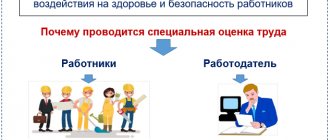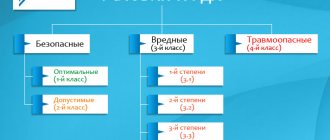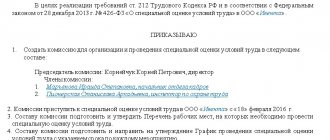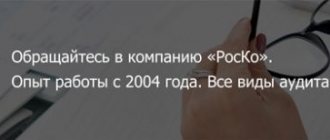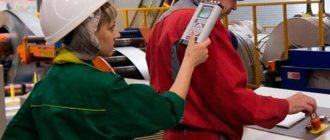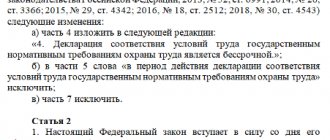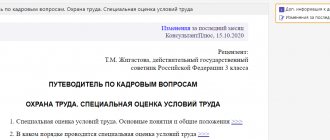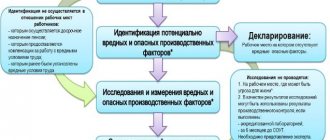According to the rules of Federal Law dated December 28, 2013 N 426-FZ, special control of working conditions is mandatory for most enterprises.
- Deadlines
- Order of conduct
An assessment of harmful and hazardous production factors present in the workplace and their possible impact on the health of employees can be carried out even after an official special safety assessment has already been carried out.
In what cases is an unscheduled special assessment of working conditions necessary, and what should you know about it? The question of how to conduct a special assessment is regulated by Federal Law No. 426-FZ, in force since January 2014, “On the special assessment of working conditions” dated December 28, 2013. According to this document, the results of the SOUT are considered valid for 5 years from the date of implementation. However, sometimes a situation may arise when you need to perform the procedure unscheduled. Let's consider these cases.
A check of a special assessment of working conditions in an unscheduled mode is carried out in the following cases:
- If a special order from the state inspection body (Rostrud) was issued to carry out the SOUT;
- If an accident occurred at the enterprise, leading to work-related injuries or death;
- If diseases have been identified in the workplace that are the consequences of exposure of workers to harmful or dangerous production factors (occupational diseases);
- If the organization has introduced new, not yet tested workplaces ( This is important!
Workplaces must already be organized, as well as the standard technological process that will take place in them. For places that have not yet been equipped, SOUT is not carried out, and is not provided for by law); - If the technological processes, raw materials or equipment used in the operation of the enterprise have been changed. To understand when an unscheduled special assessment is carried out, you should find out whether these changes can provoke the emergence of unaccounted for harmful and dangerous factors (the temperature in the workshop has changed, industrial vibrations have increased, new equipment has been put into operation, etc.);
- If new personal protective equipment began to be used to protect employees from the influence of harmful factors (this point also includes, for example, the use of warm work clothes by employees in the winter, if at the time of the special assessment in the summer this factor was not taken into account);
- If a motivated proposal to implement a repeated special assessment is put forward by a representative body of employees or a trade union organization.
What is an unscheduled SOUT?
All employers must carry out SOUT and VSOUT within the time limits established by law and, based on the results of the inspection, provide a declaration of compliance with the GIT. Russian legislation obliges all business entities to do this in order to determine the degree of impact of various factors on the health of workers at their main places of activity.
The responsible specialist conducts SOUT
Important! A special assessment of SOUT is not needed only for remote, home-based employees.
Differences from planned special assessment
Every employer is obliged to make scheduled special assessments every five years, based on the results of which classes and subcategories of working conditions at the enterprise are determined. An unscheduled SOUT is needed when there are significant changes in the production process that happened (or are about to happen) during the pause between planned special assessments. By planned we mean the previous and the future, unplanned fits into the interval between them.
Special labor assessment: planned or unscheduled
Grounds for inspection
An unscheduled special assessment of working conditions is carried out in the following cases:
- sending an order to the employer from the GIT inspector;
- industrial accident;
- diagnosing an employee with an occupational disease recognized as a result of constant contact with hazardous factors;
- initiative of the trade union body;
- introduction of new jobs into the staff structure;
- putting new equipment into operation;
- integration of innovative technologies into the production process;
- introduction of a new raw material base that can change working conditions.
Targeted training on labor protection: in what cases is it carried out?
The document that serves as the basis for performing the relevant work is an order from the manager. An order is being prepared to appoint an authorized commission.
Note! The team members include responsible officials delegated by trade union representatives.
By order, the manager establishes tasks, deadlines for carrying out work, reviewing, approving, and signing the final documentation.
Special assessment of working conditions
This procedure was introduced instead of workplace certification and largely repeats it. From January 1, 2014, employers are required to conduct a special assessment of working conditions (Federal Law of December 28, 2013 No. 426-FZ “On Special Assessment of Working Conditions”; hereinafter referred to as Law No. 426-FZ).
On December 31, 2021, the period when employers could stage-by-stage conduct a special assessment of working conditions in relation to workplaces where potentially harmful and (or) dangerous production factors were identified was completed. We are talking about the so-called safe, “non-listed” jobs, that is, those not specified in Part 6 of Article 10 of Law No. 426-FZ. In fact, most jobs fall into this category. In addition, only until this date could the results of a previously conducted certification of workplaces be valid (letter of the Ministry of Labor of Russia dated June 1, 2021 No. 15-4/10/B-4010 “On a special assessment of working conditions”). Thus, the period during which it was necessary to complete the SOUT has already expired for employers. From January 1, those who fail to fulfill this obligation may be held liable under Part 2 of Art. 5.27.1 Code of Administrative Offences. We note that responsibility for this part does not depend on the number of workers whose labor rights were violated (letter of Rostrud dated November 28, 2021 No. PG/31983-03-3).
However, firstly, those who were late should carry out a special assessment as soon as possible - in particular, the Russian Ministry of Labor promised to implement a mechanism for preventing violations in relation to small businesses and individual entrepreneurs, within the framework of which the employer will first be sent a warning about the inadmissibility of violating labor protection requirements, and only in case of non-compliance will they be fined.
In addition, a special assessment can be carried out for the first time by those who have just created new jobs. A year is allotted for this from the moment of their formation. That is, for example, if a workplace was created in December 2021, then the deadline for completing the SOUT is December 2021.
What is a special assessment of working conditions?
A special assessment of working conditions (SOUT) is carried out in order to ensure that working conditions comply with accepted standards, to ensure that the tariffs for pension contributions and contributions for injuries correspond to the current state of affairs.
An employer cannot conduct a special assessment on its own. The law states that this is a joint event, for which a specialized company with an accredited laboratory must be involved.
In this case, the assessment procedure itself and sending the report to the state control authority falls on the experts. And the customer is responsible for writing an order to carry out a special inspection and convening a commission for this purpose, drawing up a list of workplaces to be inspected.
In some cases, SOUT allows you to significantly reduce payments for additional tax and pension contributions in the event of an overestimated hazard class. For example, the lack of natural light is not currently a factor influencing the class of working conditions.
SOUTH can be planned or unplanned
A planned special assessment is carried out once every 5 years, and sometimes less often: if during the last assessment the conditions at the workplace were considered optimal or acceptable, and there were no incidents during these 5 years, then the results will be extended for another 5 years.
An unscheduled procedure is carried out:
- when new jobs appeared;
- the technological process or composition of the materials and/or raw materials used has changed;
- an industrial accident that occurred in the workplace or a detected occupational disease;
- the territorial location of the organization has changed;
- as prescribed by the GIT;
- on the motivated initiative of the trade union.
In what cases is a special assessment of working conditions carried out?
1.If this procedure has not been carried out previously
The SOUT procedure is regulated by Law of the Russian Federation No. 426-FZ and is a mandatory measure to survey the actual working conditions for each employer, regardless of the form of ownership and type of economic activity. The exception is the workplace of municipal and government employees, but the rest of the personnel serving their needs is also subject to special assessment. Consequently, a special assessment of working conditions is carried out by almost every employer in the Russian Federation.
2. Changes in production
If the production technology has changed: equipment has been replaced, new raw materials are used, a different production method is used, it is necessary to carry out a SOUT. Since the results of the previous certification are relevant for the old workplace, before changes are made to the production process.
3. Expiration of the SOUT declaration
The declaration of carrying out special assessment and assessment is valid for 5 years. This document is issued for those places where, with the approved assessment report, no harmful or dangerous factors were identified, and the working conditions were assessed as optimal or acceptable, that is, they were classified as the first or second class of conditions.
4. Proposal from employee representative bodies
If the enterprise has a representative body of workers that has put forward a reasoned proposal demanding that the SAW be carried out ahead of schedule, then the employer is obliged to heed these demands. To conduct an unscheduled assessment, the organization has six months from the date of submission of the request.
What determines the cost of a special assessment?
a) Number of jobs
The main factor influencing the price will be the number of jobs. When similar workplaces are identified, SOUT is carried out in relation to 20% of workplaces from the total number of such workplaces, but not less than two (with the same job titles, the same job descriptions, the same type of equipment and the same work schedule). Then the cost will be reduced.
b) Location of the organization
Logistics also play a huge role in determining the cost of a special assessment. After all, the further away the enterprise is located, the more expenses will be required to evaluate it.
c) Specifics of production
The more specific the production and the more factors that need to be checked, the more expensive the assessment will cost you. The most expensive studies are chemical or radiation, but these costs cannot be avoided, because the list of factors to be checked depends on the specifics of the workplace.
Conducting a Special Assessment of Working Conditions can only be carried out by organizations that have passed the accreditation procedure (recognition of competence), received a certificate and are included in the register of accredited organizations (https://akot.rosmintrud.ru/sout/organizations).
When VSUT is not required
There is no need for an unscheduled special assessment of working conditions in the following cases:
- due to the reorganization procedures performed, the registration details and the legal name of the business entity changed, but the conditions for conducting business remained without adjustments;
- changes were made to the current staffing table, such as renaming positions, but the actual functionality and workplace of the performing employee were not affected;
- a new contractor has been hired, but there have been no recent adjustments to working conditions at the workplace;
- if the accident occurred, it was due to the fault of third parties, which can be proven, or on the territory of the enterprise, but in a workplace that is not assigned to the employee.
Certification of workplaces or special assessment of working conditions
The decision that an unscheduled inspection at the scene of an incident or simply at the enterprise will not be carried out is made by a specially assembled commission.
Note! Based on the results of its meeting and the issues considered, a protocol is drawn up (it must comply with legal requirements; samples are available on the Internet and in enterprise standards).
Who is required to conduct SOUT and within what time frame?
Unscheduled and planned SOUT should be carried out in the following cases:
- an order was issued from Rostrud to carry out appropriate actions;
- there was an accident that resulted in serious consequences (injuries, death);
- During inspections at workplaces, diseases were discovered that were a consequence of the negative impact of hazardous production factors on employees (in other words, occupational diseases);
Labor assessment at different sites
- new jobs were introduced;
- the company began to use new equipment, raw materials or materials that it had not previously used;
- in order to protect against occupational hazards, personal protective equipment has been centrally introduced;
- the proposal is motivated and put forward by a workers' body or trade union organization.
Important! Workplaces before the SOUT must be arranged and equipped, otherwise inspection will be impossible.
Deadlines
Unscheduled inspections are carried out within a period of at least six months after the corresponding need has arisen and has been declared. But in some cases, the terms increase to one calendar year.
Note! Repairs and redevelopment of the premises being inspected are not included in the list of conditions for the assessment, with the exception of situations where the new dimensions of the premises are too small and have a negative impact on the work of employees.
Why is an order issued to carry out special assessment and assessment work?
All management decisions are enshrined in orders. All of them are compiled in free form.
After the director has decided to conduct a special assessment, he enshrines this decision in an order. You also need to create an order appointing members of the commission that will participate in the assessment .
These 2 orders can be combined into one.
The order is issued to streamline activities and determine the circle of persons participating in the special assessment. According to Part 4 of Art. 9 of Law No. 426-FZ, the director is the chairman of such a commission. The commission, together with the director, must include at least 3 people, the number of its members must be odd.
The procedure for conducting an unscheduled special assessment
When a unified system for certifying workplaces at enterprises was in effect, unscheduled assessments were regulated by paragraphs. 47-48 of Order 324, but the new Federal Law-426 abolished it. The current procedure and stages of assessment of an extraordinary type are as follows:
- Preparatory work - a list of jobs that will be assessed is determined, an expert firm is selected, and a commission is formed.
- Identification of potentially dangerous, harmful factors is mandatory with further declaration of the degree of compliance of the current parameters with the declared ones.
- Measuring the degree of influence of these factors is necessary to determine the hazard class.
- Approval of the report on the assessment results - according to the sample.
- Declaration of data.
The inspector makes notes based on the results of the inspection
The management of the enterprise needs to prepare for the SAW, since workplaces are assessed first, especially if they are supposedly affected by harmful factors to the maximum.
Note! Preparation and payment for the inspection are the employer’s obligations.
Responsibility for non-compliance with legislation
If the enterprise has not inspected workplaces in accordance with the SOUTH
, or errors were made during the inspection, the following fines are provided:
- for individual entrepreneurs and enterprise managers - 5-10 thousand rubles.
- for legal entities - 60-80 thousand rubles.
For failure to comply with the rules for drawing up an additional agreement
a fine in the amount of 50-100 thousand rubles is provided for the main employment contracts indicating the results of the SOUT audit.
No guarantees or compensation
from the moment of approval of the results of the SOUT - 5-25% of the amount of funds used for other purposes.
Ignoring the requirement to provide employees with the necessary protective equipment
in accordance with the SOUT check - 130-150 thousand rubles.
Failure to comply with the rules for conducting medical examinations
employees on the basis of SOUT - a fine of 110-130 thousand rubles.
